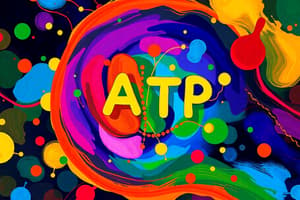Podcast
Questions and Answers
What is the relationship between the Gibbs free energy (ΔG) of a reaction and whether it is spontaneous?
What is the relationship between the Gibbs free energy (ΔG) of a reaction and whether it is spontaneous?
- A reaction is spontaneous if the ΔG is zero.
- A reaction is spontaneous if the ΔG is negative. (correct)
- A reaction is spontaneous if the ΔG is positive.
- The Gibbs free energy is not related to whether a reaction is spontaneous.
What happens to the energy of the reactants in an exergonic reaction?
What happens to the energy of the reactants in an exergonic reaction?
- Energy is released into the surroundings. (correct)
- The energy of the reactants remains unchanged.
- The energy of the reactants increases.
- Energy is absorbed from the surroundings.
Which of the following statements accurately describes the relationship between the Gibbs free energy (ΔG) and the spontaneity of a reaction?
Which of the following statements accurately describes the relationship between the Gibbs free energy (ΔG) and the spontaneity of a reaction?
- A reaction with a negative ΔG is spontaneous. (correct)
- A reaction with a positive ΔG is spontaneous.
- A reaction with a negative ΔG is non-spontaneous.
- A reaction with a positive ΔG is neither spontaneous nor non-spontaneous.
How does the energy in the products compare to the energy in the reactants in an exergonic reaction?
How does the energy in the products compare to the energy in the reactants in an exergonic reaction?
What is the significance of the term 'spontaneous' when describing a chemical reaction?
What is the significance of the term 'spontaneous' when describing a chemical reaction?
What does the first law of thermodynamics state?
What does the first law of thermodynamics state?
What is the Gibbs Free Energy (∆G) of a system?
What is the Gibbs Free Energy (∆G) of a system?
What are some examples of energy forms that cells convert?
What are some examples of energy forms that cells convert?
Which of the following is NOT a process that cells use energy for?
Which of the following is NOT a process that cells use energy for?
How does the First Law of Thermodynamics relate to cellular processes?
How does the First Law of Thermodynamics relate to cellular processes?
What is the relationship between Gibbs Free Energy (∆G) and Entropy (∆S) in living systems?
What is the relationship between Gibbs Free Energy (∆G) and Entropy (∆S) in living systems?
Why is it important to consider Gibbs Free Energy (∆G) when studying cellular processes?
Why is it important to consider Gibbs Free Energy (∆G) when studying cellular processes?
Which of the following is NOT a factor that affects Gibbs Free Energy (∆G)?
Which of the following is NOT a factor that affects Gibbs Free Energy (∆G)?
What is the defining characteristic of living organisms that differentiates them from a closed system in terms of Gibbs free energy?
What is the defining characteristic of living organisms that differentiates them from a closed system in terms of Gibbs free energy?
Which of the following scenarios would represent a reaction with a positive Gibbs free energy change (ΔG > 0)?
Which of the following scenarios would represent a reaction with a positive Gibbs free energy change (ΔG > 0)?
In the context of Gibbs free energy, what is the key distinction between an isolated hydroelectric system and an open hydroelectric system?
In the context of Gibbs free energy, what is the key distinction between an isolated hydroelectric system and an open hydroelectric system?
Which of the following statements accurately describes a catabolic pathway in a cell?
Which of the following statements accurately describes a catabolic pathway in a cell?
Why is a negative Gibbs free energy change (ΔG < 0) associated with a spontaneous reaction?
Why is a negative Gibbs free energy change (ΔG < 0) associated with a spontaneous reaction?
What is the significance of the statement "Reactions in a closed system eventually reach equilibrium and then do no work" in relation to living organisms?
What is the significance of the statement "Reactions in a closed system eventually reach equilibrium and then do no work" in relation to living organisms?
Which of the following choices would correctly represent the change in Gibbs free energy (ΔG) for a reaction that requires energy input to occur?
Which of the following choices would correctly represent the change in Gibbs free energy (ΔG) for a reaction that requires energy input to occur?
Which of the following statements is the most accurate description of Gibbs free energy (ΔG)?
Which of the following statements is the most accurate description of Gibbs free energy (ΔG)?
What is the name for the process of breaking down complex molecules into simpler compounds?
What is the name for the process of breaking down complex molecules into simpler compounds?
Which of the following is an example of a metabolic pathway?
Which of the following is an example of a metabolic pathway?
What is the role of enzymes in metabolic pathways?
What is the role of enzymes in metabolic pathways?
Why is the regulation of metabolic pathways important?
Why is the regulation of metabolic pathways important?
What is the main difference between catabolic and anabolic pathways?
What is the main difference between catabolic and anabolic pathways?
Why is metabolism considered an emergent property of life?
Why is metabolism considered an emergent property of life?
What is the role of ATP in metabolism?
What is the role of ATP in metabolism?
According to the second law of thermodynamics, what is the tendency of energy transfer and transformations?
According to the second law of thermodynamics, what is the tendency of energy transfer and transformations?
What does the Gibbs Free Energy (ΔG) represent in a chemical reaction?
What does the Gibbs Free Energy (ΔG) represent in a chemical reaction?
Which statement correctly describes the relationship between enthalpy (H), entropy (S), and Gibbs Free Energy (ΔG)?
Which statement correctly describes the relationship between enthalpy (H), entropy (S), and Gibbs Free Energy (ΔG)?
What does it mean if the Gibbs Free Energy (ΔG) for a reaction is less than zero (ΔG < 0)?
What does it mean if the Gibbs Free Energy (ΔG) for a reaction is less than zero (ΔG < 0)?
In a biological system, how do the changes in enthalpy (H) and entropy (S) typically manifest in living cells?
In a biological system, how do the changes in enthalpy (H) and entropy (S) typically manifest in living cells?
Which of the following is NOT a component of the thermodynamic driving force of a chemical reaction?
Which of the following is NOT a component of the thermodynamic driving force of a chemical reaction?
What is the main reason why energy is lost as heat during energy transfer or transformation?
What is the main reason why energy is lost as heat during energy transfer or transformation?
Which of the following represents the correct interpretation of the Gibbs Free Energy equation: ΔG = H - TΔS?
Which of the following represents the correct interpretation of the Gibbs Free Energy equation: ΔG = H - TΔS?
Flashcards
Energy
Energy
The capacity to cause change or do work.
Catabolic reactions
Catabolic reactions
Reactions that break down molecules to release energy.
First Law of Thermodynamics
First Law of Thermodynamics
Energy cannot be created or destroyed, only transformed.
Kinetic Energy
Kinetic Energy
Signup and view all the flashcards
Chemical Energy
Chemical Energy
Signup and view all the flashcards
Gibbs Free Energy (∆G)
Gibbs Free Energy (∆G)
Signup and view all the flashcards
Inverse relationship between ∆G & ∆S
Inverse relationship between ∆G & ∆S
Signup and view all the flashcards
Internal Energy
Internal Energy
Signup and view all the flashcards
Metabolism
Metabolism
Signup and view all the flashcards
Metabolic Pathway
Metabolic Pathway
Signup and view all the flashcards
Catabolism
Catabolism
Signup and view all the flashcards
Anabolism
Anabolism
Signup and view all the flashcards
Enzyme
Enzyme
Signup and view all the flashcards
Cellular Respiration
Cellular Respiration
Signup and view all the flashcards
Photosynthesis
Photosynthesis
Signup and view all the flashcards
Biochemical Regulation
Biochemical Regulation
Signup and view all the flashcards
Gibbs Free Energy
Gibbs Free Energy
Signup and view all the flashcards
Exergonic Reaction
Exergonic Reaction
Signup and view all the flashcards
ΔG < 0
ΔG < 0
Signup and view all the flashcards
Reactants
Reactants
Signup and view all the flashcards
Products
Products
Signup and view all the flashcards
Usable Energy
Usable Energy
Signup and view all the flashcards
Entropy
Entropy
Signup and view all the flashcards
Second Law of Thermodynamics
Second Law of Thermodynamics
Signup and view all the flashcards
Enthalpy (H)
Enthalpy (H)
Signup and view all the flashcards
Gibbs Free Energy (ΔG)
Gibbs Free Energy (ΔG)
Signup and view all the flashcards
Spontaneous Reaction
Spontaneous Reaction
Signup and view all the flashcards
Equilibrium in Reactions
Equilibrium in Reactions
Signup and view all the flashcards
Non-Spontaneous Reaction
Non-Spontaneous Reaction
Signup and view all the flashcards
Free Energy (ΔG)
Free Energy (ΔG)
Signup and view all the flashcards
Open System
Open System
Signup and view all the flashcards
Metabolism and Equilibrium
Metabolism and Equilibrium
Signup and view all the flashcards
Study Notes
Biology 1 - Cells, Molecular Biology and Genetics (Biol 1000)
- Course instructor: Dr. Michael Cardinal-Aucoin
- Course offering: Winter 2025
- Course code: Biol 1000
Metabolism (Chapter 8)
- Metabolism is the totality of an organism's chemical reactions
- Metabolism transforms matter and energy
- Metabolism is an emergent property of life that arises from interactions between molecules within the cell.
- Metabolic pathways are organized into steps catalyzed by specific enzymes, which are typically regulated at the level of one of these enzymes.
Overview of Metabolism
- Catabolism breaks down substances, such as in digestion
- Anabolism builds up substances, for example protein synthesis in muscle
- Catabolic pathways release energy by breaking down complex molecules into simpler compounds
- Cellular respiration involves the breakdown of glucose in the presence of oxygen to form CO2, water, and ATP.
Basic Thermodynamics and Energy
- All chemical systems (e.g., organisms, cells) contain energy, which is also referred to as enthalpy (H).
- Cells convert energy from one form to another. Forms include kinetic energy (movement), chemical energy (stored in chemical bonds), light energy, and electrochemical potential energy (e.g., concentration gradient).
- Energy can be transferred or transformed but it cannot be created or destroyed (First Law of Thermodynamics).
- During every energy transfer or transformation, some energy is unusable and is often lost as heat (Second Law of Thermodynamics).
- Entropy is a measure of disorder.
- Gibbs free energy (ΔG) is the proportion of a system's energy that can perform work. A negative ΔG means the reaction is spontaneous. A positive ΔG means the reaction is non-spontaneous.
Exergonic and Endergonic Reactions
- Exergonic reactions release energy (ΔG < 0) and are spontaneous.
- Endergonic reactions absorb energy (ΔG > 0) and are non-spontaneous.
- Gibbs free energy is the difference in energy between reactants and products.
Enzymes
- Enzymes are proteins that accelerate a chemical reaction by decreasing the activation energy (Ea).
- Enzymes do not alter the free energy (ΔG) of the reaction.
- The activation energy (Ea) is the minimum amount of energy required before collisions between reactants will give rise to products.
- The active site is the region of an enzyme where the substrate binds.
- Induced fit of a substrate allows the enzyme to better catalyze the reaction.
- Enzymes can be affected by cofactors and coenzymes.
- Enzymes are specific and can exhibit different optimal conditions such as temperature and pH.
- Feedback inhibition involves the end product of a metabolic pathway inhibiting an earlier step in the pathway.
- Enzymes can be regulated through phosphorylation.
Enzyme Action
- Various factors can affect enzyme activity, including substrate concentration, competitive inhibition, allosteric activation, and phosphorylation.
ATP
- ATP is the energy currency of the cell and is used to do work.
- Cells use ATP to do chemical work (e.g., polymerization), transport work (e.g., transporting substances), and mechanical work (e.g., moving structures like cilia).
- ATP drives endergonic reactions by the reaction of ATP hydrolysis (breaking down)
- ATP is a renewable resource regenerated in the cell by adding a phosphate group to ADP.
Studying That Suits You
Use AI to generate personalized quizzes and flashcards to suit your learning preferences.




